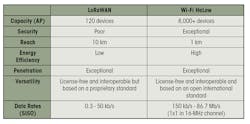What’s the Difference Between Wi-Fi HaLow and LoRaWAN?
What you’ll learn:
- A comparison of Wi-Fi HaLow with LoRaWAN.
- How Wi-Fi HaLow delivers the reach and energy efficiency to meet the demands of IoT applications.
Smart and connected devices comprising the Internet of Things (IoT) continue to multiply. By some estimates, the number of IoT devices worldwide will reach more than 29 billion in 2030, while others predict that number to be closer to 129 billion. Regardless of the exact number you choose to believe, what everyone agrees with is that IoT is expanding rapidly. And, with such growth, so grows the expectations for our IoT networks.
What is LoRaWAN?
Released in 2015, LoRaWAN is described by the LoRa Alliance as a low-power, wide-area (LPWA) networking protocol designed to wirelessly connect battery operated “things” to the internet in regional, national, or global networks. The LoRa Alliance is an open, non-profit organization dedicated to promoting LoRaWAN.
LPWA networks (LPWANs) typically offer data rates from 0.3 to 50 kb/s at ranges of up to 10 km in open rural environments,1 and are usually managed by service providers. LoRaWAN, like other LPWANs, provides low-bandwidth connectivity to battery-powered sensor devices.
There’s generally enough bandwidth for communication of small amounts of sensor data, but not enough to provide over-the-air (OTA) software updates, for example. The low data rates also severely constrain the security offered by LPWANs, despite IoT security being a major focus for governments around the world.
The New Kid on the Block
Wi-Fi HaLow was engineered from the ground up in direct response to the IoT surge. As the latest MAC/PHY (medium access control/physical layer) certification released by the Wi-Fi Alliance, Wi-Fi HaLow incorporates IEEE 802.11ah and provides the most comprehensive, feature-rich protocol available today for secure, long-reach, power-sensitive IoT applications.
According to the Wi-Fi Alliance, it may be “the IoT wireless standard offering the best combination of range, throughput, density, low-power operation, and deployment costs.”
Scalability
Let’s begin examining some of the attributes of Wi-Fi HaLow that distinguish it from LoRaWAN (see table). A single Wi-Fi HaLow access point (AP) can handle thousands of devices, which provides exceptional scalability for enterprises deploying large numbers of connected devices to automate operations, enhance communication, and maintain facilities.
According to a recent Lancaster University study, a single LoRaWAN gateway can support 120 end devices (based on the assumption that each end device transmits 20 bytes every 16.7 minutes).
Keeping IoT Environments Secure
As an IEEE 802.11 Wi-Fi protocol, Wi-Fi HaLow adheres to a globally recognized standard for the secure authentication and communication of connected devices. It supports the latest Wi-Fi requirements for authentication (WPA3) and AES encryption of OTA traffic, with data rates that enable secure OTA firmware upgrades.
In addition, Wi-Fi HaLow can easily adapt to future IoT security requirements and changes. Because it’s regarded as a best practice, the Wi-Fi Alliance employs formal external security reviews when developing any security-related protocols, such as Easy Connect.2
LoRaWAN, however, doesn’t offer equivalent security assurances and doesn’t appear to have been subject to formal external review by security experts. The LoRa Alliance claims, “LoRaWAN is by design very secure—authentication and encryption are, in fact, mandatory,” but then concedes, “networks and devices can be compromised if security keys are not kept safe, not randomized across devices, or if cryptographic numbers used once (nonces) are reused.”
These compromises have been identified by a number of security researchers, such as in an article published in the journal, Internet of Things. It found “[LoRaWAN] suffers from several security and privacy vulnerabilities that could compromise availability, authentication, and privacy.” Also note that although it makes use of AES encryption, the use of counter mode by LoRaWAN has severe flaws.3 Furthermore, due to its small packet size, LoRaWAN is less able to fix current security problems or adapt to future IoT security requirements.
Impressive Reach
A device using Wi-Fi HaLow can communicate with another device at ranges of over 1 km using the sub-1-GHz band, and at relatively high throughput rates.4 Sub-1-GHz signals are also extremely effective at passing through walls and other obstacles.
By comparison, LoRaWAN, using the same band, offers coverage of up to 10 km in rural environments but at low data rates and only where there are few obstructions. This suits it for highly rural deployments, such as large farms looking to connect a few sensors over tens of kilometers.
In urban environments, though, LoRaWAN coverage may be diminished. Also, connections can be lost in high-density scenarios because LoRaWAN uplinks use an inefficient unslotted Aloha MAC protocol.5
Energy Efficiency
Wi-Fi HaLow requires only a fraction of the power of other versions of Wi-Fi. LoRaWAN, by comparison, is a low-power protocol that separates devices into three classes (A, B, and C), with Class A devices designed primarily for power efficiency.
For enterprises looking to scale their IoT networks and send more than a few bytes of sensor data, LoRaWAN can’t match the energy efficiency (energy required to transmit a unit of information) of a Wi-Fi HaLow network.
License-Free and Interoperable
Both Wi-Fi HaLow and LoRaWAN use the unlicensed and class licensed sub-1-GHz band, ranging from 850 to 950 MHz. The Wi-Fi Alliance’s certification program gives consumers confidence that all Wi-Fi CERTIFIED HaLow branded products will interoperate. The LoRa Alliance offers certification against the LoRaWAN specification for LoRaWAN products rather than interoperability testing.
Data Rates
Wi-Fi HaLow provides a range of data rates ideally suited for IoT devices. Using a single spatial stream at the narrowest bandwidth of 1 MHz yields data rates from 150 kb/s using MCS 10 with binary phase-shift keying (BPSK) modulation, to a top rate of 4.4 Mb/s using MCS 9 (modulation and coding scheme).
In an 8-MHz operating channel, a single stream Wi-Fi HaLow AP can support a mix of IoT devices from very-low-power sensors, sending 1-MHz packets at rates down to 150 kb/s, to cameras sending 8-MHz packets at rates up to 43 Mb/s. This throughput surpasses LoRaWAN’s data-transfer rate (0.3 to 50 kb/s) by a large margin. LoRaWAN’s low data rates are inadequate for IoT networks that transmit anything more than very small data packets.
What’s Next?
While LoRaWAN is often touted as a universal protocol for long-reach, low-power networks, its reality often doesn’t live up to the expectations of IoT developers. Most real-world IoT applications require higher network capacity, faster data rates, and more robust security than LoRaWAN currently provides or will be able to provide in the future.
Those real-world requirements point to a better wireless solution: Wi-Fi HaLow, the first Wi-Fi standard optimized for the needs of the IoT.
References
1. https://en.wikipedia.org/wiki/Low-power_wide-area_network
2. https://www.wi-fi.org/discover-wi-fi/wi-fi-easy-connect
3. https://www.cyber-threat-intelligence.com/publications/IoTDI2018-LoraWAN.pdf
5. https://www.sciencedirect.com/science/article/pii/S0140366422002444

